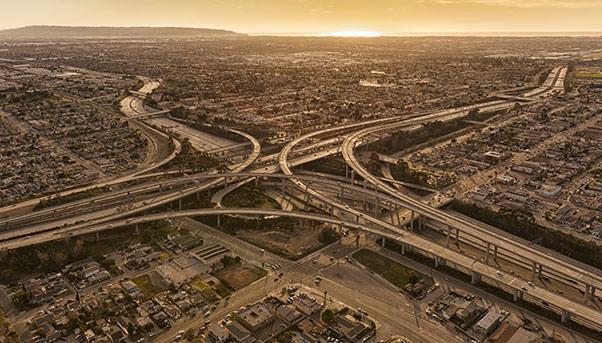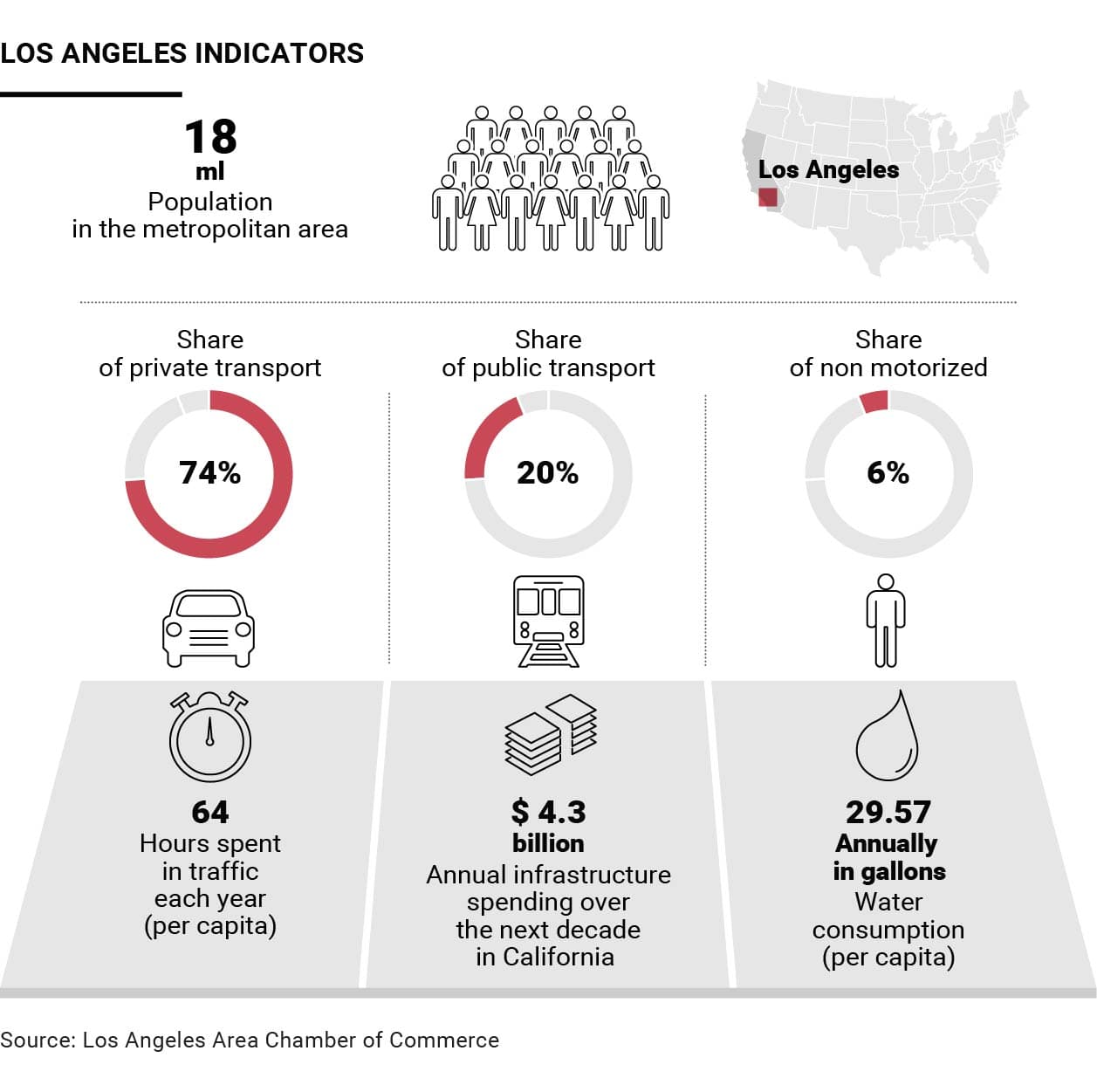
Like a carpet being unrolled across the ground, Los Angeles seems to keep growing larger and larger. This huge metropolis now stretches 47 kilometres from east to west and 71 kilometres from north to south, reaching as far as the eye can see from Santa Monica to Pasadena, from Burbank to Manhattan Beach. And it is destined to grow still more.
The greater Los Angeles area boasts a population of 18 million, the second-busiest airport in the United States and the fourth-busiest in the world, the busiest port in the Western Hemisphere and a multi-ethnic population where the large presence of Latinos is transforming the city into a bilingual enclave.
Los Angeles is hungry: hungry for land, for development, for innovation. This unstoppable appetite is the driver of the city’s attraction to infrastructure. Streets, bridges, water systems, energy networks, dams: all of them must contribute to the city’s transformation.
Its historic inclination for real estate development obliged Los Angeles to build some of the largest road, electric and water networks in the world. But today they are no longer enough. Climate change and a continually growing population means that Los Angeles continues to be a large importer of water and energy. Renewing its energy sources is a key goal for the city administration and according to the Los Angeles Area Chamber of Commerce the city will increase its installed solar energy capacity by 2035 by between 1,500-1,800 MW. At the same time, it aims to progressively disinvest in coal-fired energy and aims to close all coal plants by 2025.
The expected population increase will impact not just the city’s energy needs, but will also put pressure on the public transport network. According to the Los Angeles Area Chamber of Commerce, the metropolis has the worst traffic problem in the United States, forcing its residents to spend 62 hours in traffic jams on average each year.
It is numbers like these that have convinced the city and state governments to launch the sort of large new infrastructure projects that will enable to city to meet its future commitments.
The Olympic challenge
Los Angeles is already looking ahead to 2028, when it will host the Summer Olympic Games. The city government has vowed not to waste money in building new stadiums and other structures that will be of little use after the games are over, but rather to use the opportunity to invest in new infrastructure. The last time the Games were held in Los Angeles in 1984 they earned a profit of $225 million (the only one in modern history) and the city built a transport network that is still in use today.
The city wants to be ready in time for 2028, so much so that the California State Transport Agency, which manages the state’s transport infrastructure, has drawn up a short term “to do” list. Among these is a long delayed plan to finish the Freeway 710 serving the ports of Los Angeles and Long Beach (where Salini Impregilo is building the new Gerald Desmond Bridge); extending the public transport network, starting from the Purple Line and the Orange Line; and a mega project to treat and manage waste water that today ends up in the ocean.
Infrastructure in Los Angeles: The transport challenge
Right now only about 20% of Los Angeles residents use public transport, a figure that shows the extent to which the network needs a large amount of investment and development.
That’s why the Purple Line is being extended at a cost of $7.8 billion. By 2024 the line will be 9 miles longer with 7 new stations, adding 49,000 passengers daily and creating 52,500 new jobs.

The Crenshaw Line, instead, is completely new light metro and will join two existing lines, the Expo Line and the Green Line, covering a distance of 8.5 miles. The project calls for an investment of $2.1 billion and work should be finished in 2019.
The third big project already underway is a 1.9-mile line that will add three new stations in Downtown Los Angeles, with a budget of $1.8 billion and opening in 2021.
These projects bring Los Angeles in line with other global cities like New York with its Second Avenue Subway, London with its Crossrail and the Grand Paris Express, which will connect the French capital with 100 surrounding communities.
Los Angeles: A city looking ahead to the future
The $64 billion high speed train being built to connect San Francisco is the most traditional of the new forms of transport that will be tested in the coming years in the Californian megalopolis. Ride-sharing company Uber said it aims to test its first flying cars for use as taxis in Los Angeles. The idea seemed realistic enough to be mentioned at the end of November by Los Angeles Mayor Eric Garcetti during a meeting with the San Fernando Valley business community. After mentioning Uber’s project, the mayor reminded listeners that Jet Propulsion Laboratory has set up a facility at Union Station to test flying cars, with the goal of using them as ambulances.
Just as futuristic is the Hyperloop project backed by Elon Musk, founder of SpaceX. This superfast transport tube would use a tunnel to connect the San Francisco Bay Area with Los Angeles at speeds reaching 1,000 kilometres per hour.
California State’s commitment
California has the highest GDP of any U.S. state, making it one of the largest economies in the world, and Los Angeles is one of its beating hearts. Investing in infrastructure becomes therefore an instrument to support economic growth.
Last year the state of California submitted a $100 billion list to the Federal Government of infrastructure projects it says are necessary to modernize the Golden State’s worn-out streets and bridges.
Along with the federal funding, the state will contribute, and Governor Jerry Brown has pledged to insert $4.3 billion more in infrastructure spending each year over the next decade.
The money is necessary. The American Society of Civil Engineers said in its latest report that California needs $44.5 billion to fix its water treatment plants, $26.2 billion for its water network, and urgent intervention on 678 dams it considers in need of maintenance. These projects will have a huge impact on future development plans for Los Angeles, the giant metropolis destined to grow larger still.

